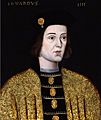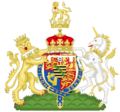Duke of York facts for kids
Quick facts for kids Dukedom of York |
|
|---|---|
| Creation date | 23 June 1986 |
| Creation | Eighth |
| Monarch | Elizabeth II |
| Peerage | Peerage of the United Kingdom |
| First holder | Edmund of Langley |
| Last holder | Andrew Mountbatten Windsor |
| Remainder to | the 1st Duke's heirs male of the body lawfully begotten |
| Subsidiary titles |
|
| Status | Extant, not in use |
The Duke of York is a special title of nobility in the United Kingdom. For a long time, since the 1400s, this title has usually been given to the second son of the King or Queen of England (and later, Britain). A similar title in Scotland was the Duke of Albany.
The title of Duke of York has been created eight times since it first appeared in the 1300s. Sometimes, it was even combined with "Albany" to become the Duke of York and Albany. This happened three times in the 1700s after England and Scotland joined together. The double name showed a connection to both parts of the new kingdom.
Most recently, Queen Elizabeth II gave this title to her second son, Prince Andrew, when he got married in 1986. It was announced on 17 October 2025 that he would no longer use the title. On 30 October 2025, his name was removed from the official list of nobles, and he was stripped of his royal titles and honours.
Contents
- Exploring the History of the Duke of York
- The City of York and Its Importance
- First Duke: Edmund of Langley (1385)
- Second Duke: Richard of Shrewsbury (1474)
- Third Duke: Henry Tudor (1494)
- Fourth Duke: Charles Stuart (1605)
- Fifth Duke: James Stuart (1633/1644)
- Dukes of York and Albany
- Sixth Duke: Prince George (1892)
- Seventh Duke: Prince Albert (1920)
- Eighth Duke: Prince Andrew (1986)
- Pretenders to the Title
- Places and Things Named After the Dukes of York
- Images for kids
- See also
Exploring the History of the Duke of York
The City of York and Its Importance
The city of York has always been a very important place in Northern England. Even today, it is home to the archbishop of York, a senior church leader, a role that dates back to AD 735. The region around it, Yorkshire, is also England's largest county.
Long ago, during the Middle Ages, York was known by its Viking name, "Jorvik." It was even a small kingdom for a while. Before the first Duke of York was named, there were several "Earls of York" who held power in the area.
First Duke: Edmund of Langley (1385)
The very first time the Duke of York title was created was in 1385 for Edmund of Langley. He was a son of King Edward III. His son, Edward, later inherited the title. Sadly, Edward died in a famous battle called the Battle of Agincourt in 1415.
After Edward, the title went to his nephew, Richard. Richard's father had been executed for plotting against King Henry V. Richard worked hard to get the title back. Eventually, his eldest son became King Edward IV in 1461. When a Duke of York becomes king, their title "merges into the Crown," meaning it becomes part of the king's own titles.
Second Duke: Richard of Shrewsbury (1474)
The title was created again for Richard of Shrewsbury. He was the second son of King Edward IV. Richard is famous for being one of the "Princes in the Tower." He disappeared and was believed to have died without any children, so his title ended.
Third Duke: Henry Tudor (1494)
The third Duke of York was Henry Tudor, the second son of King Henry VII. His older brother, Arthur, was supposed to be king. But when Arthur passed away in 1502, Henry became the next in line. He later became the famous King Henry VIII in 1509, and his Duke of York title merged with the Crown.
Fourth Duke: Charles Stuart (1605)
The title was given a fourth time to Charles Stuart, the second son of King James I. His older brother, Henry Frederick, was the first in line to the throne. When Henry died in 1612, Charles became the next heir. He was made Prince of Wales in 1616 and later became King Charles I in 1625. Again, the Duke of York title merged with the Crown.
Fifth Duke: James Stuart (1633/1644)
The fifth Duke of York was James Stuart, the second son of King Charles I. This Duke of York is very famous because many places in America are named after him! In 1664, his brother, King Charles II, gave James a large area of land in America. After the English took control of this land from the Dutch, the main city, New Amsterdam, was renamed New York City in James's honor. A fort further north was also renamed Albany, after James's Scottish title, Duke of Albany. When his brother, King Charles II, passed away without children, James became King James II in 1685. His Duke of York title then merged with the Crown.
Dukes of York and Albany
In the 1700s, a new combined title, the Duke of York and Albany, was created three times.
- The first was for Duke Ernest Augustus, who was King George I's youngest brother. He had no children, so the title ended.
- The second was for Prince Edward, the younger brother of King George III. He also passed away without children, and the title ended.
- The third and last was for Prince Frederick Augustus, the second son of King George III. He was a leader in the British Army and is even the "Grand old Duke of York" from the famous nursery rhyme! He also had no children, so the title ended again.
Sixth Duke: Prince George (1892)
The Duke of York title was created for the sixth time for Prince George. He was the second son of the Prince of Wales, who later became King Edward VII. George became Duke of York after his older brother, Prince Albert Victor, passed away. When George became King George V, the title merged with the Crown.
Seventh Duke: Prince Albert (1920)
The seventh Duke of York was Prince Albert, the second son of King George V. He was the younger brother of the future King Edward VIII. Albert became king unexpectedly when his brother decided to step down. He took the name George VI, and his Duke of York title merged with the Crown.
Eighth Duke: Prince Andrew (1986)
The title was created for the eighth time for Prince Andrew, the second son of Queen Elizabeth II. He married Sarah, Duchess of York, and they have two daughters, Princess Beatrice and Princess Eugenie. Since he did not have any sons, the title would have ended upon his death and returned to the Crown.
However, Prince Andrew stepped back from royal duties in 2019. Following discussions with the King, he agreed on 17 October 2025 to stop using his Duke of York title and other related titles. On 30 October 2025, Buckingham Palace announced that King Charles III had started a formal process to remove Andrew's titles and honours. His name was then removed from the official list of nobles. This means the title cannot be used on official documents. However, the dukedom has not yet returned to the Crown. If Andrew were to have a son, that son would still inherit the dukedom.
It is interesting to note that, except for the very first Duke, every time the Duke of York title has been created, it has only had one person hold it. That person either became king or passed away without any sons to inherit the title.
Pretenders to the Title
Sometimes, people have claimed the title of Duke of York even when it wasn't officially theirs.
- In the late 1400s, a person named Perkin Warbeck tried to claim the throne by pretending to be Richard of Shrewsbury, the second Duke of York who had disappeared.
- In the early 1700s, James Francis Edward Stuart, who believed he should be king, gave the title "Duke of York" to his second son, Henry Benedict Stuart. Henry later became a cardinal in the Catholic church and was known as the Cardinal Duke of York. However, because James was not recognized as king by English law, this title was not considered official.
Places and Things Named After the Dukes of York
Many places and things around the world have been named in honor of the Dukes of York over the centuries.
Geographic Features
Southern Hemisphere
- Cape York Peninsula, Australia
- Duke of York Island, Antarctica
- Duke of York Island, Papua New Guinea
- Duke of York Islands, Papua New Guinea
Canada
- Duke of York Archipelago, Canada
- Duke of York Bay, Canada
Political Entities
Canada
- York, Upper Canada, which is now Toronto, Ontario
- York County, New Brunswick, Canada
United States
- New York, a U.S. state
- New York City, the largest city in the United States.
Schools
- Duke of York's Royal Military School, Dover, Kent, United Kingdom
- Duke of York School, Nairobi, Kenya, which was renamed Lenana School in 1963.
Pubs
- Duke of York, Bloomsbury
- Duke of York Inn, Elton
- The Duke of York, Fitzrovia
- Duke of York, Ganwick Corner
Ships
- HMS Duke of York (1763), a small ship bought in 1763.
- HMS Duke of York (17), a large battleship launched in 1940.
- Hired armed cutter Duke of York
- Hired armed lugger Duke of York
- TSS Duke of York (1894)
- TSS Duke of York (1935)
Railways
- A train named Duke of York was part of the GWR 3031 Class locomotives used on the Great Western Railway between 1891 and 1915.
Military Music
There is also a military march called "Duke of York." It is used for inspections and slow marches. The melody was composed in 1789 by John Gamidge.
Images for kids
See also
 In Spanish: Duque de York para niños
In Spanish: Duque de York para niños
- Duke of Albany
- Duke of York and Albany
- Earl of Inverness, a smaller title of the current Duke
- Baron Killyleagh, another smaller title of the current Duke
- Henry Benedict Stuart, who was given the title Duke of York by his father, the "King James III" (who was not recognized as king by British law). Henry lived in Italy as a cardinal and was known as the "Cardinal Duke of York." He passed away in 1807 without children.
















